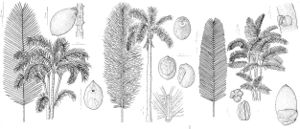Roystonea regia
Science ser. 2, 12:479. 1900.
Stems gray-white, 30 m, diam. 35–41 cm, smooth. Leaves: segments inserted on rachis in several ranks at divergent angles, giving leaf anappearing almost plumose appearance. Inflorescences to 1 m; rachillae 11–31 cm, stiff. Flowers white; anthers pinkish. Fruits ripening from green through red to purplish black at maturity, dorsiventrally compressed obovoid, 9.5–10.5 mm, diam. 7.4–7.8 mm. 2n = 36.
Phenology: Flowering from winter-- through summer (Jan–Jul).
Habitat: Tropical hardwood hammocks and mixed swamp vegetation in peat soils over limestone
Elevation: 0–10 m
Distribution

Fla., se Mexico, West Indies (Cuba), West Indies (Bahamas), West Indies (Cayman Islands)
Discussion
The Florida populations, once known as Roystonea elata, are conspecific with the Cuban R. regia (S. Zona 1996, 1997). A proposal to conserve Oreodoxa regia over Palma elata W. Bartram, the older basionym, has been accepted, because the name R. regia is so widely used (R. K. Brummitt 1996; S. Zona 1994).
Roystonea attracted the attention of William Bartram (1791), who described the palm growing near Lake Dexter, along the St. Johns River in what areis now Lake and Volusia counties. That this palm naturally grew so far north of its present range in historical times is an intriguing puzzle. J. G. Cooper (1861) believed that Tthe severe freeze of 1835 may have extirpated the northern populations (J. G. Cooper 1861). O. F. Cook (1936) suggested that Perhaps fires used by early settlers to clear land reduced the number of Roystonea palms in northern and central Florida (.O. F. Cook 1936). J. K. Small (1937) suggested that Or, in addition to freezes in 1835 and 1894–95, overexploitation by humans may have extirpated the palms (J. K. Small 1937); Smallhe reported that a factory in the vicinity of Bartram’s population turned out walking sticks made of palm wood. Whatever the historical reason for their decline, indigenous populations of R. regia are now found only in Collier and Dade counties.
Flowers of Roystonea attract numerous bees and are probably insect pollinated. The fruits, available April through October, are eaten by birds and bats, which are the likely dispersers of the seeds (S. Zona and A. Henderson 1989).
Selected References
None.
